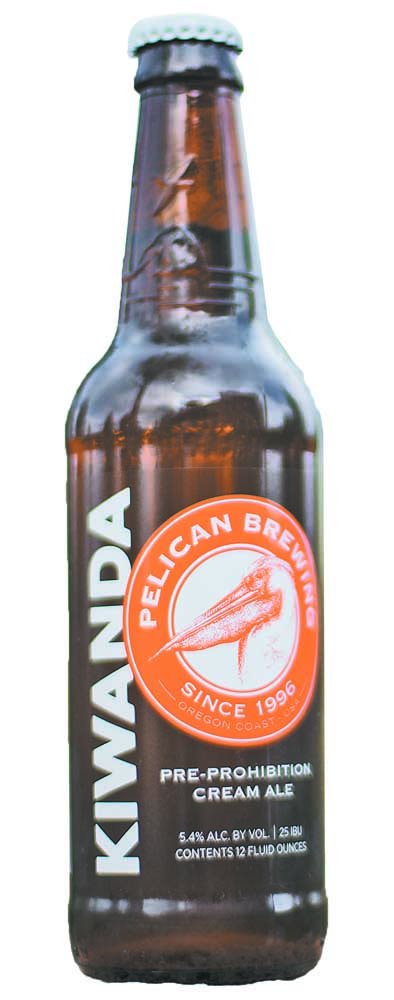Need a lawn mower beer? Try an American cream ale
Published 12:00 am Sunday, May 19, 2019

- A popular Oregon cream ale is Pelican Brewing Company’s Kiwanda Cream Ale.(Ryan Brennecke/Bulletin photo)
Spring has sprung in recent weeks, and the return of warm weather means the return of yard work. After a hot afternoon of mowing the lawn, nothing refreshes quite like a lawn mower beer: light, crisp and cold.
There are plenty of perfectly appropriate thirst quenching styles to follow up a session of grass cutting, but one I have a soft spot for is the classic American cream ale.
Considered one of the few indigenous American beer styles, cream ale was created in the late 1800s as an ale competitor to pale lager beers. So, to understand cream ale, we need to understand lagers.
Centuries ago, German brewers developed a method of conditioning beer at low temperatures for an extended period of time, which matured and clarified the beer. This method, known as lagering from the German for storing, was typically carried out in caves or special cellars filled with ice prior to the 19th century.
This conditioning process is one of the major differentiators from ales. Another is the yeast. Lager yeast is known as bottom-fermenting, meaning it tends to sink to the bottom of the liquid to work, while ale yeasts float to the top. Lager yeasts also perform best at lower temperatures, which gives the finished beer a cleaner flavor, hence the longer time in cold storage.
The need for cooler temperatures kept these beers confined to seasonal brewing during cold months, and they didn’t travel well. That changed in the mid-19th century with the advent of artificial refrigeration. Suddenly, lagers could be brewed year-round and stored cold until ready to serve. By the late 1800s, pale lagers and Pilsner in particular, rose to prominence and became the world’s No. 1 style of beer.
In America, the mid-19th century influx of German immigrants included brewers who brought lager brewing with them. As elsewhere, lagers became the popular choice among consumers. Ales of the time were dark, heavy, unfiltered brews that held little appeal to drinkers when offered a clear, easy-drinking Pilsner.
In order to compete, American ale brewers developed lighter styles made to resemble lagers.
Variously known as present-use ale, sparkling or lively ale, or cream ale, they were sometimes fermented with lager yeasts at warmer temperatures, and sometimes with ale yeasts and subsequently cold conditioned. One of the hallmarks of the style was the use of America’s native grain — corn — along with barley in order to lighten the color and body of the finished ale.
Despite the term cream ale, dairy has nothing to do with the style. There is no definitive historical reference for where this term came from, though I suspect a marketing influence, as these beers were highly carbonated and would likely have been poured with tall, creamy heads of foam.
Cream ale is largely an ale version of a standard American lager, with similar color and strength, though it should be more aromatic and flavorful. More hop character and some ale fruitiness is common.
One of the classic examples available today is Genesee Cream Ale. Introduced in 1960, it’s smooth with some corn sweetness and a subtle earthy hop flavor that’s easy to miss.
Modern craft brewing versions tend to be more robust and hoppy, and many are brewed with all barley malt and no corn. In Oregon, Pelican Brewing Company of Pacific City offers perhaps the best-known version with its Kiwanda Cream Ale. Styled as a pre-prohibition cream ale, this version is crisp and refreshing with a nice floral hop character.
I’ve also enjoyed an excellent Cream Ale from Astoria’s Buoy Beer Company. Crisp, clean, with a touch of earthy Willamette hops, it’s a terrific example of the style. Buoy cans this beer, so look for it on the shelves at your favorite beer store.
Here in Central Oregon, cream ales tend to be seasonal or one-off beers rather than mainstays. Deschutes Brewery occasionally releases one and often tinkers with the style, with a lineup including a Nitro Cream Ale, a fresh hop version, and most recently, Guatemalan Gold Coffee Cream Ale brewed with coffee from Nossa Familia Roasters.
Sunriver Brewing Company has offered Cool Water Cream Ale in past summer months that I’ve enjoyed. It’s an excellent example of the style: light and easy drinking with a golden color and grainy flavor. According to head brewer Brett Thomas, if Sunriver brews Cool Water again this year, it would likely be on tap in July or August.
You might expect a beer named Krispy Cream Ale to taste something like a doughnut, but this beer from 10 Barrel Brewing Company is brewed to style. The brewery includes flaked corn in the grist for an authentic touch of corny sweetness followed by a crisp finish.
Keep an eye out for more examples of this classic American style, and pick some up for that next time you’ve got a day of yard work ahead of you.
— Reporter: chuggnutt@gmail.com








